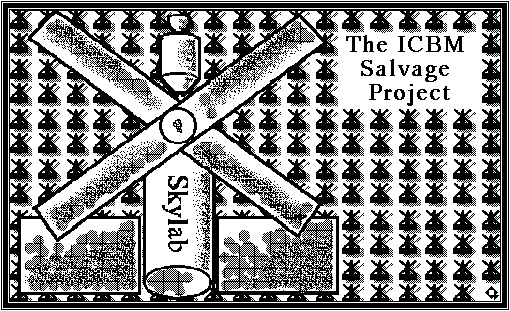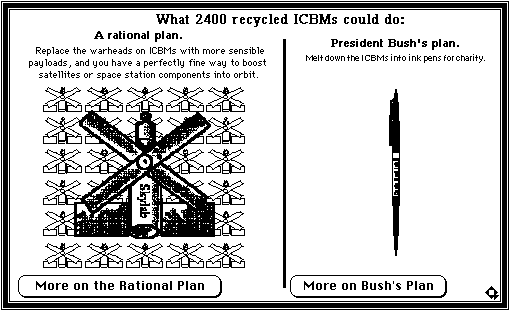

Introduction to the ICBM Salvage Proposal
_________by J.R. Mooneyham_________
(Free JavaScripts provided by The JavaScript Source)
       (Translate this site) |
| Search this site | Site map | Site author | Site store | >>> | Latest site updates | <<< | Access Google's cache of this site |
|
Alternative (mirror site) links | Translate this site | | Site search | Site map | Site author | | Access Google's cache of this site |
|
I came up with the ICBM Salvage Proposal in a fit of anger and disbelief, sparked by a CNN Headline News report I saw on or about Oct. 18, 1991. The report said the Bush administration had proposed melting down all the ICBMs into ink pens for charity.
I immediately wrote everyone I could think of, including Bush, various journalists, and certain Congressmen, pointing out another alternative ( as outlined in this FLUX article ).
The dissappointing response I received for these initial efforts spurred me to greater action. I composed a 16 inch by 21 inch poster about the subject and mailed it out to a couple of hundred different people and organizations around the nation, over the next year. As should be obvious from this article ( which is mostly a derivation of that poster's graphics and text ), my presentation was highly critical of the Bush Administration and NASA, due to their positions on the subject.
What is the status of all the significant elements involved as of today ( 3- 1- 93 )?
The Whole Earth Review's Spring 92 issue carried one of my early letters.
There was also a seemingly related editorial in an issue of OMNI magazine, by Ben Bova ( a member of one of the groups I shipped posters to ).
George Bush was defeated in the election.
And a small startup company called Kontinental Astro-Transport International ( KATI ), dedicated to essentially carrying out an ICBM Salvage plan of their own, was born in Virginia.
( They recently invited me to accompany them on a related flight to Russia. )
Don't get the wrong idea, however. Things are far from settled on this front. KATI is primarily composed of American sci fi fans/ engineers, and Eastern European engineers thrown out of work by the turmoil over there. So they're all struggling heroically to convert old Cold War surplus into New World assets. Also, one of the last things the Bush Administration tried to do before leaving office was kill off this tiny enterprise ( and others like it ) entirely.
Write your Congressman! Don't let the guys at the top waste more than a trillion dollars worth of assets that could be used to revitalize both the American and global economies.
Don't forget that government policies imposed from the top ( Presidential or Congressional levels ) often have a life and momentum of their own, long after the guys responsible for them have left office. Bush set a lot of things in motion before he left that could result in the complete or near total loss of all these launchers for use in practical space development projects.
As a result, mankind's leap into space could be set back by a century or more.
After examining the full content of the proposal, I hope you'll decide to add your voice to mine in this matter.
J.R.M.•

More on the Rational Plan
by J.R. Mooneyham
2400 ICBMs could put into orbit an estimated 3, 000 tons of assorted satellites, robotic platforms, or space station components within the next three to six years, at a huge discount over the past. This would be roughly the equivalent of thirty Skylabs*, each equipped with its own Apollo class command/ service module. The previous illustration, depicting Skylab over a background 30 similar stations, accurately portrays the quantity of equipment these missiles could put into orbit.
About forty percent of these missiles are in the U.S. arsenal. The rest are in the Soviet store. The Soviets are in desperate need of hard currency. Therefore, it would make sense for America and Western Europe to 'buy' the Soviet missiles for their own use. One arrangement might net us ( the U.S. ) approximately 1700 missiles total ( 700 Soviet rockets plus our own 1000 ) and Europe 700, if the supply were divided evenly.
The greatest historic obstacle to space exploitation has now been removed:
The greatest barrier to cost-effective space development has always been the high cost of orbit-capable launchers. Now we have hundreds or thousands of surplus ICBM rockets becoming available for the task, already bought, paid for, and manufactured.
Orbiting factories could give national Earth-side installations an edge over foreign competitors:
"Super computers" on-a-chip manufactured in space could be brought back Earthside and embedded in American products across-the-board, making our goods "smarter" and more versatile than those of other nations. Even better, our Earthside facilities would require little or no modifications to benefit from this plan.
A long term boost to global economic growth and technological innovation:
Using the ICBM rocket power to install an industrial base in orbit would present long term benefits as well. The space shuttle/ space truck would at last have a practical mission and destination. Space development overall could be accelerated by decades, indirectly quickening the pace of global innovation generally, with all the benefits that implies for everyone.
A way to ease the conversion of defense industries to consumer oriented markets:
The creation of two dozen or more large space platforms and all their various support equipment would require significant work from many defense related industries; this new work would help to soften the pain of transition to consumer goods, triggered by the end of the Cold War.
Please help save our future. Don't let the ICBMs be melted down for ink pens.
By simply spreading the word about all this, you could help prevent it from happening.•
More on Bush’s Plan
by J.R. Mooneyham
On or about Oct. 18, 1991, CNN Headline News reported the Bush administration had proposed melting down all the ICBMs into ink pens for charity.
The author of this article ( see "Introduction to the ICBM Salvage Proposal" ) immediately wrote everyone he could think of, including Bush, pointing out the other alternative ( see "More on the Rational Plan" ).
The author was then informed by several parties, which included NASA and the Defense Department, that allowing such use of these surplus ICBMs would hurt certain companies that produce rockets today, by reducing their sales for at least two or three years ( After that, of course, sales would actually be boosted by the presence of factories in orbit, and the fact that the inventory of missiles would run out. ).
NASA admits recycling the ICBMs could work; but they're opposed to the idea anyway:
Mr. Arnold D. Aldrich, Associate Administrator for Space Systems Development at NASA, in a letter dated Dec. 13, 1991, said of the ICBMs......" They may potentially offer relatively low-cost access to space for some users." He also states that..."Another key consideration is that some U.S. entrepreneurial firms have made considerable investments in the last decade in the development of new commercial space launch vehicles incorporating modern technology. These firms worry that the infusion of large numbers of surplus missile stages into the launch market would jeopardize their investments..." .
The author was also informed that the Department of Defense and NASA are working up a set of recommendations for the government on what to do with these "surplus missile stages".
NASA has a record of killing proposals for alternative launching systems. It did it years ago to protect the Space Shuttle program itself from possible competition. It will doubtless do it again, regardless of the possible benefits for taxpayers that could be garnered from such a recycling of a trillion dollars worth of equipment ( roughly the total amount spent by the U.S. and the Soviet Union over forty years of development and procurement to build the ICBM fleets. ).
Short-sighted officials at NASA and billion dollar defense contractors would rather throw away a trillion dollars worth of our future than endure even a brief reduction in budgets or prestige due to the existence of an ICBM-based space development project.
Since the ICBMs could possibly present a competitive threat to NASA and some wealthy defense contractors for two to six years ( remember, the missile inventory would run out fairly quickly in an ambitious development project ), there's little doubt what NASA and the defense contractors' lobbyists on capitol hill will recommend.
Please help save our future. Don't let the ICBMs be melted down for ink pens.
By simply spreading the word about all this, you could help prevent it from happening.•
Contacting Kontinental Astro-Transport International
This information may be out of date by the time you get it. But here's the best information available at the time of publication.
The Constitution of Kontinental Astro-Transport International:
Purpose:
To provide commercial, civilian, and scientific clients with space launch services by an international joint-venture import company.
Methods:
In general, the company acquires retired-from-service mobile military rockets currently being removed from the arsenal of the former Soviet Union. These are still in operable condition; only the warheads are removed. Solid fuel vehicles such as the SS- 16 and SS- 20 are preferred to reduce the number of servicing vehicles and crew personnel required. The launch teams will preferably be hired from retired members of the same teams that maintained and trained to launch these vehicles while in active service.
Advantages:
1. Almost infinitely more launch sites and times become available, since these mobile launchers are designed to launch from unprepared sites on short notice, and can be shipped worldwide.
2. Proven, rugged hardware is used instead of experimental prototypes.
3. Proven launch and servicing procedures are used by personnel who have logged time-on-type.
4. Assets that are currently planned to be wasted will generate profit, and greatly contribute to low-cost access to space.
5. After launch, the transporters retain considerable resale value as airport utility or construction vehicles.
Contact information:
B. Rutledge
4318 Cedarlake Ct.
Alexandria, VA 22309
If the above information proves outdated, contact us here at FLUX and we'll try to provide you with any new information available.
J.R.M. 12- 27- 92 •
Who to Lobby for the ICBM Salvage Project
The most effective people to lobby about the ICBM Salvage Project would be your Congressional Representatives or state Senators. Writing the President or Vice President might be useful too.•